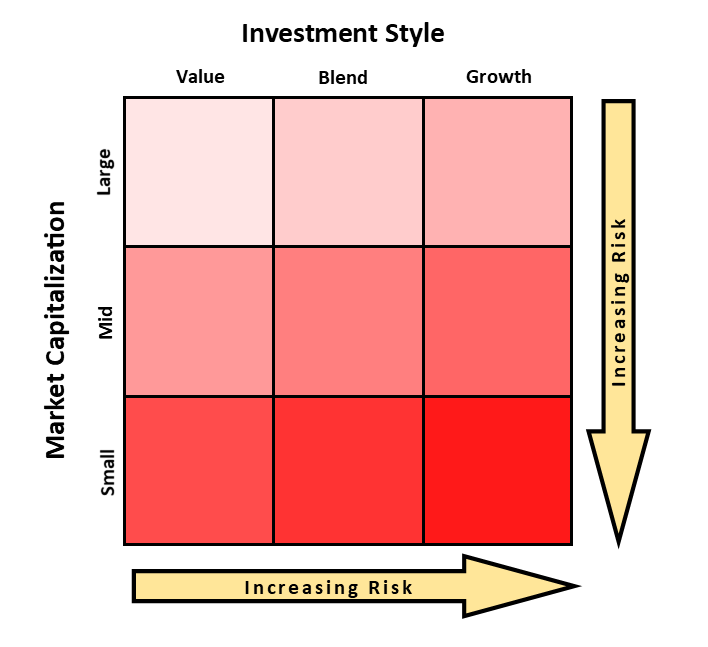Investment Fundamentals: The Mutual Fund Style Box
by Mitchell J. Smilowitz, CPA
This is the third in a series on Investment Fundamentals. It builds on concepts from the first two articles: market capitalization and growth and value investing styles.
The Mutual Fund Style Box categorizes funds on the basis of market capitalization and investment style. Morningstar, Inc., a mutual fund research company that provides data and research services to investors, developed the style box to make it easier to understand a mutual fund’s investment objectives and strategy. The JRB uses the Morningstar Style Box™ to categorize the funds we offer. You can use it to evaluate your portfolio’s diversification and balance between risk and return.
In this article we’ll focus on the domestic equity style box (see below). In general, the colors reflect the relative risk and volatility of the funds in each category. Risk and volatility tend to increase as you move from left to right and from top to bottom. For example, Large-cap/Value funds tend to be less risky and volatile. Small-cap/Growth funds tend to carry greater risk and volatility.

The vertical axis reflects market capitalization. A large-cap company has a market value over $10 billion. Mid-cap companies have a market value between $2 billion and $10 billion. Companies with a market value below $2 billion are considered small-cap.
The horizontal axis categorizes the fund by investment style — whether it implements a value, growth or blend strategy. Mutual funds that invest in companies with lower P/E ratios are considered value funds; funds that hold companies with higher P/E ratios are considered growth funds. Blend funds invest in both growth and value stocks.
Price-to-Earnings Ratio Defined The price-to-earnings (P/E) ratio measures the relationship between a company’s stock price and the company’s earnings per share of stock. For example, a company’s stock sells for $50 per share. Earnings average $5 per share. Price ($50) divided by earnings ($5) equals a P/E ratio of 10. The average P/E ratio of U.S. stocks since 1946 is about 17. |
Most domestic stock mutual funds can be placed in one of these nine boxes. In general, a value-oriented fund contains mostly stocks the manager thinks are currently undervalued in price. A growth-oriented fund will hold the stocks of companies that the portfolio manager believes will increase earnings and/or revenue faster than the rest of the market. A blend fund holds a mix of growth and value stocks.
From what we know about market capitalization and the concepts of value and growth, we understand that mutual funds in the small-cap/growth box are likely to have greater potential for higher returns at the cost of heightened volatility. Funds in the large-cap/value box are likely to be less volatile.
Have questions about whether your asset allocation accurately reflects your risk-return profile? Contact the JRB via email or call 888-JRB-FREE (572-3733).
Putting JRB Domestic Stock Funds in the Style Box
The following chart assigns each domestic equity fund the JRB offers to the Style Box. The JRB funds are categorized as they are described in each fund’s prospectus. A fund’s actual investment style can “drift” from a category. Drift can occur because a company the fund owns moves from one category to another (for example, a small-cap company may grow to become a mid-cap company).
| Value | Blend | Growth | |
| Large | JPMorgan Equity-Income Select | ||
| Mid | Goldman Sachs Small/Mid Cap Growth R6 | ||
| Small | Loomis Sayles Small-Cap Inst |
For more information on the Morningstar Style Box™, click here.
July 2018
